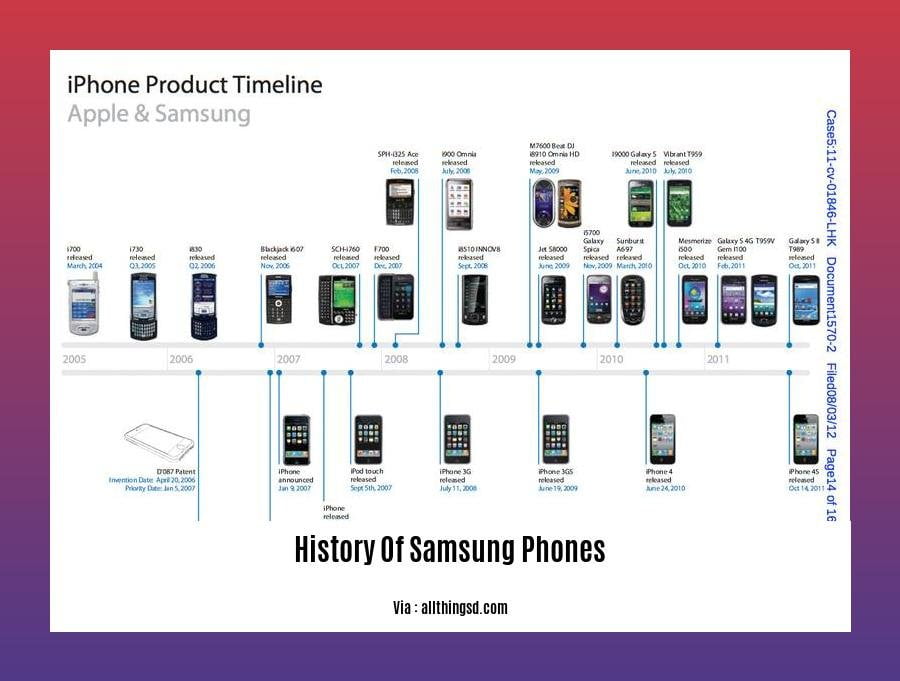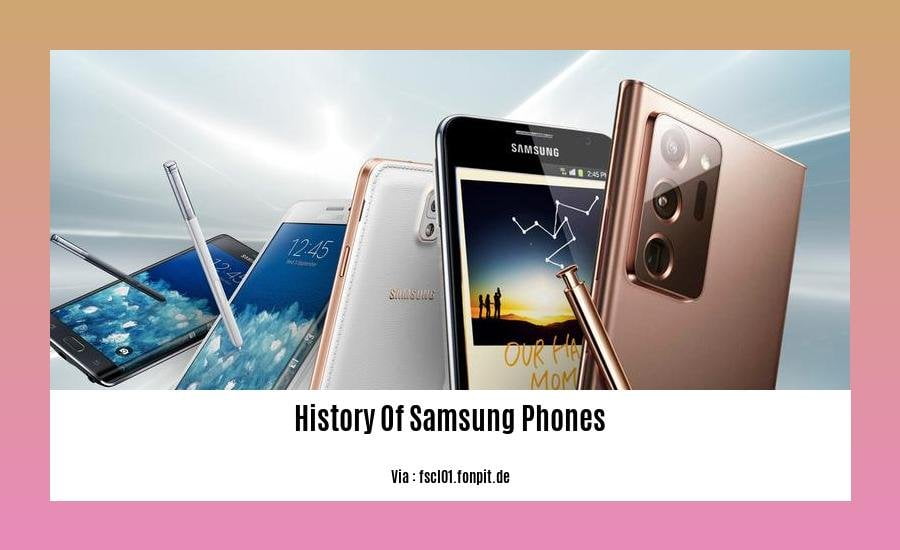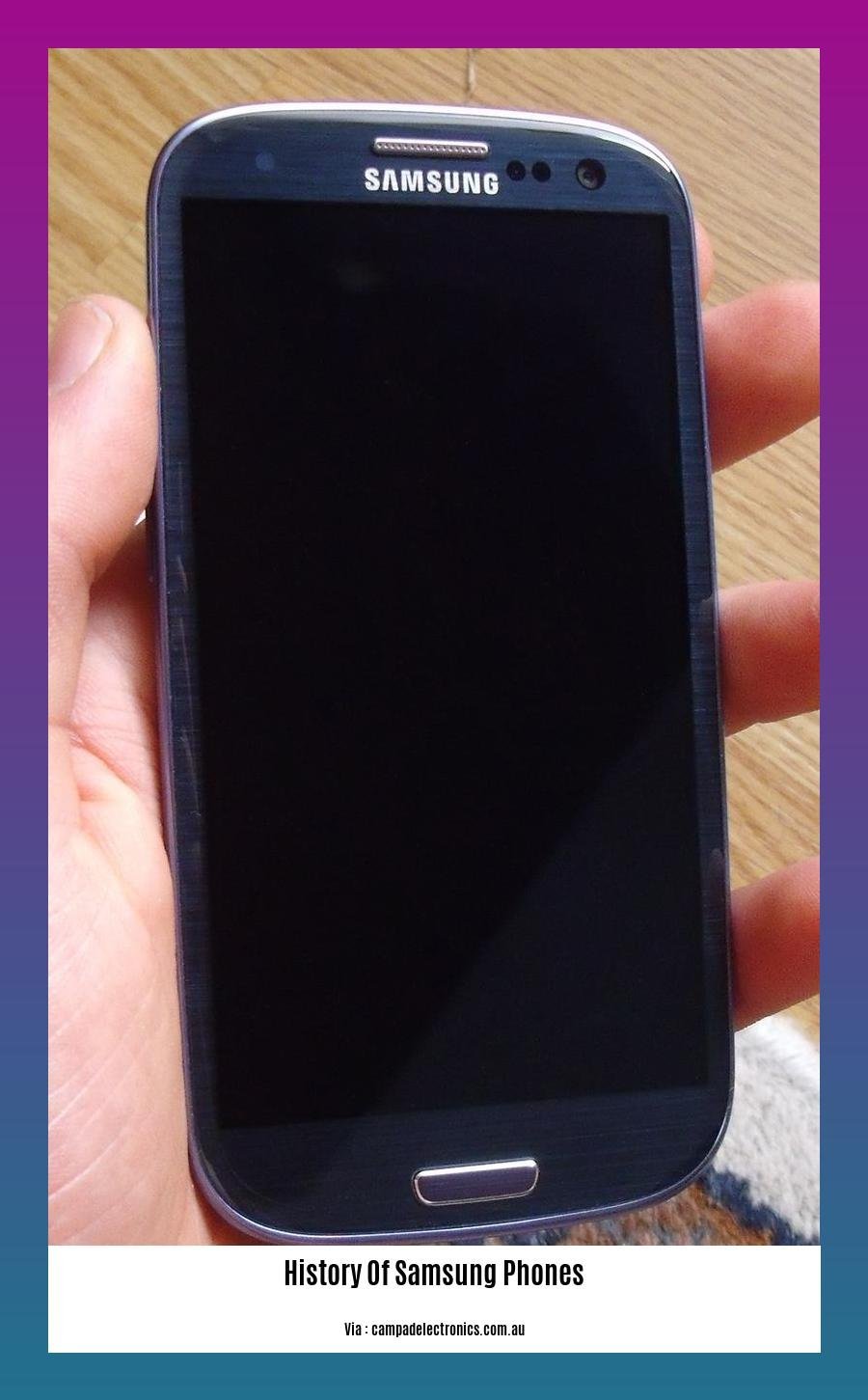From humble beginnings to becoming a global tech titan, Samsung’s journey in the mobile phone industry is a riveting tale of innovation, market dominance, and the rise of a true pioneer. [- The History of Samsung Phones: Innovation, Market Dominance, and the Rise of a Global Giant] unveils the pivotal moments, technological milestones, and strategic decisions that propelled Samsung to the forefront of the mobile phone revolution, shaping the way we communicate, consume content, and navigate the digital world.
Key Takeaways:
Samsung’s journey in the smartphone industry has been a story of innovation, evolution, and global dominance.
Samsung’s first CDMA smartphone, the SPH-I300 in 2001, set the stage for their entry into the mobile technology market.
The Samsung SGH-i607 BlackJack (2006) introduced a full QWERTY keyboard, bringing productivity-focused features to the forefront.
Samsung’s Instinct (2008) and Omnia (2008) showcased advanced multimedia capabilities and customizable interfaces, capturing the attention of tech-savvy consumers.
The Samsung Vibrant (2010) and Focus (2010) marked Samsung’s entry into the Android and Windows Phone platforms, respectively, demonstrating their adaptability to different操作系统.
The Samsung Galaxy S II (2011) was a milestone device, boasting a dual-core processor, larger display, and improved camera system, setting the tone for future flagship smartphones.
Samsung’s collaboration with Google on the Galaxy Nexus (2011) showcased the latest Android operating system and a sleek design, further strengthening their partnership.
History Of Samsung Phones

A Legacy of Innovation and Market Dominance
Samsung’s Meteoric Rise in the Smartphone World
Samsung’s journey in the mobile phone industry has been nothing short of remarkable, evolving from a humble beginner to a global giant that has redefined the smartphone landscape. This journey is a testament to the company’s unwavering commitment to innovation, its ability to adapt to shifting market dynamics, and its knack for creating devices that resonate with consumers worldwide.
Early Steps and the Genesis of a Mobile Empire
Samsung’s foray into the mobile phone market began in the early 2000s, a time when the industry was dominated by established players like Nokia and Motorola. Undeterred by the fierce competition, Samsung embarked on a mission to carve out its own niche, focusing on creating feature-rich phones that offered users a seamless and intuitive experience.
The Arrival of the Samsung Galaxy: A Game-Changer
The launch of the Samsung Galaxy S in 2010 marked a watershed moment in the company’s history. This groundbreaking device, powered by Google’s Android operating system, took the market by storm with its sleek design, powerful performance, and user-friendly interface. The Galaxy S set the stage for a new era of mobile innovation, propelling Samsung to the forefront of the smartphone revolution.
The Galaxy’s Reign and Samsung’s Global Dominance
With each subsequent generation of the Galaxy series, Samsung continued to refine and enhance its flagship smartphone, setting new industry benchmarks and capturing a growing share of the global market. The Galaxy S2, S3, and S4 became synonymous with cutting-edge technology, pushing the boundaries of what a smartphone could do.
Innovation Beyond the Flagships: A Diverse Smartphone Portfolio
While the Galaxy series spearheaded Samsung’s rise to prominence, the company also recognized the importance of catering to diverse consumer needs and preferences. Samsung’s mid-range and budget-friendly smartphone offerings, such as the Galaxy A and J series, proved immensely popular, further solidifying the company’s position as a dominant player in the global smartphone market.
Conclusion: A Legacy of Pioneering the Mobile Frontier
Samsung’s remarkable journey in the smartphone industry serves as an inspiration to businesses worldwide. The company’s unwavering focus on innovation, its ability to adapt to changing market dynamics, and its dedication to creating user-centric devices have been instrumental in its rise to global dominance. As the mobile landscape continues to evolve, Samsung stands poised to maintain its leadership position, shaping the future of mobile technology and enriching the lives of countless consumers worldwide.
To learn about the journey of Samsung cell phones over the years, take a trip down memory lane with our extensive history article: history of samsung cell phones.
For an intriguing account of how Samsung’s Galaxy S series came to be, delve into our comprehensive historical exploration: History Of Samsung Galaxy S Phones.
Embark on a captivating journey through the evolution of Samsung’s mobile phones, from humble beginnings to industry-leading innovations: History Of Samsung Mobile Phones.
Uncover the intriguing narrative of Samsung Electronics’ rise to becoming a global powerhouse: History Of Samsung Electronics.
Discover the pivotal moment that marked the birth of Samsung’s smartphone legacy in our comprehensive timeline: When Was Samsung Smartphone Invented.
Rise to Prominence and Global Expansion

Navigating the intricate landscape of the mobile phone industry, Samsung, a company synonymous with innovation, embarked on a transformative journey that would propel it to the forefront of the global smartphone market. From humble beginnings, Samsung’s ascent to the summit of mobile technology was orchestrated through a symphony of strategic decisions, pioneering innovations, and an unwavering commitment to customer-centricity.
The Genesis of a Legacy: From Humble Beginnings to a Global Stage: Emergence of Samsung Galaxy
Samsung’s foray into the mobile phone market took root in the early 2000s, a period characterized by intense competition and a crowded field of established players. Unfazed by the daunting landscape, Samsung identified an opportunity to differentiate itself by partnering with Google to harness the burgeoning power of the Android operating system. In 2010, the Samsung Galaxy S, powered by Android, burst onto the scene, marking a pivotal moment in the company’s history. The Galaxy S, with its sleek design, intuitive interface, and robust features, struck a chord with consumers worldwide, signaling Samsung’s arrival as a formidable force in the smartphone arena.
Conquering Heights: Innovation and Market Dominance
With the success of the Galaxy S, Samsung embraced a relentless pursuit of innovation, recognizing that staying ahead in the dynamic world of mobile technology demanded a continuous stream of groundbreaking products. Each subsequent generation of the Galaxy series pushed the boundaries of what was possible, introducing cutting-edge features and refining the user experience. The Galaxy SII, SIII, and S4 captivated audiences with their larger displays, faster processors, and improved cameras, solidifying Samsung’s position as a leader in the smartphone industry.
Beyond Flagships: Expanding Horizons with Mid-Range and Budget-Friendly Offerings
While Samsung’s flagship devices garnered widespread acclaim, the company recognized the importance of catering to a broader spectrum of consumers. The Galaxy A and J series emerged as affordable alternatives to the premium Galaxy S lineup, striking a balance between price and performance. These mid-range and budget-friendly offerings proved immensely popular, particularly in emerging markets, propelling Samsung’s global expansion and cementing its position as a brand accessible to consumers across socioeconomic strata.
Key Takeaways:
Samsung’s alliance with Google and the adoption of the Android operating system proved instrumental in its initial success.
Unwavering commitment to innovation and continuous refinement of the Galaxy series solidified Samsung’s position as a technological trailblazer.
Strategic expansion into mid-range and budget-friendly segments enabled Samsung to tap into a wider consumer base, driving its global dominance.
Samsung’s customer-centric approach, adaptability to changing market dynamics, and dedication to creating user-friendly devices contributed to its rise as a global smartphone giant.
Citations:
Samsung Galaxy S Series: A History of Innovation
How Samsung Became a Global Smartphone Leader
Galaxy Revolution: A Chronicle of Innovation and Global Dominance
From humble beginnings to global dominance, Samsung’s journey in the smartphone industry can only be described as revolutionary. Galaxy Revolution takes us through the highlights of Samsung’s mobile phone evolution, where we’ll see how the company transformed from an underdog into the undisputed leader in the smartphone market.
The Galaxy Era Begins:
In 2010, Samsung unveiled the game-changer, the Galaxy S. This Android-powered smartphone wowed the world with its user-friendly interface, powerful hardware, and an eye-catching design. With the Galaxy S, Samsung signaled its intent to challenge the dominant players in the smartphone market.
Conquering the Market:
The Galaxy S didn’t stop at being just a great phone; it became a phenomenon. The successor models, the Galaxy S II and S III, built on the success of its predecessor, becoming even more popular and solidifying Samsung’s position as a global smartphone powerhouse.
A Myriad of Choices:
Samsung didn’t limit its success to its flagship devices. The Galaxy A and J series, targeting the mid-range and budget-friendly segments, also saw immense popularity. This strategy allowed Samsung to cater to a wider audience, further cementing its dominance in the market.
Innovation Unbound:
Innovation has been the driving force behind Samsung’s success. From the revolutionary foldable Galaxy Fold to the camera prowess of the Galaxy S Ultra, Samsung has constantly pushed the boundaries of what’s possible in the mobile world.
Key Takeaways:
- Samsung’s dominance in the smartphone market is a result of its dedication to innovation, user-centric design, and aggressive marketing strategies.
- The Galaxy S series set the benchmark for Android smartphones, pioneering features that became industry standards.
- Samsung’s mid-range and budget-friendly offerings, like the Galaxy A and J series, made smartphones accessible to a broader audience.
- Samsung’s constant pursuit of innovation has led to groundbreaking devices like the Galaxy Fold and the Galaxy S Ultra, shaping the future of mobile technology.
Sources:
– Samsung Galaxy history: how Samsung’s superphone has evolved over the past 13 years
– The Evolution of Samsung Phones – The History of The Samsung Galaxy Phone
Legacy and Impact: Samsung’s Journey in reshaping Mobile Tech
Samsung’s journey in the mobile phone industry is nothing short of a revolution. Like a shooting star, they ignited their path towards global dominance with the launch of their first Galaxy S smartphone in 2010. Since then, they’ve consistently pushed the boundaries of innovation, pioneering an era of sleek designs, powerful processors, and groundbreaking features. Their relentless pursuit of excellence has transformed the mobile experience, leaving an indelible mark on the industry and everyday lives.
Key Takeaways:
Samsung, the reigning smartphone titan, rose from humble beginnings to become the epitome of mobile innovation.
Their pioneering spirit, displayed through the Galaxy series, unveiled a world of endless possibilities, redefining the smartphone as an indispensable tool.
Samsung’s mastery in merging cutting-edge technology with consumer needs shattered boundaries, leaving a legacy of iconic devices that continue to reshape the mobile landscape.
Samsung’s commitment to innovation didn’t just revolutionize the mobile experience; it had a ripple effect, inspiring competitors to push their limits, resulting in an ecosystem thriving with diversity and progress.
With every new Galaxy release, Samsung demonstrates an unwavering dedication to pushing boundaries, constantly challenging the definition of what’s possible in a smartphone.
[Citation:
Samsung Galaxy history: how Samsung’s superphone has evolved over the past 13 years
The Evolution of Samsung Phones – The History of The Samsung Galaxy Phone]
FAQ
Q1: What was the first Samsung Galaxy smartphone?
A1: The first Samsung Galaxy smartphone was the Samsung Galaxy S, released in 2010. It featured a 4-inch Super AMOLED display and a 1GHz Hummingbird processor.
Q2: Which Samsung Galaxy smartphone was the most successful?
A2: The Samsung Galaxy SIII was the most successful Samsung Galaxy smartphone, selling over 50 million units in its first six months. It introduced features like S Voice, Smart Stay, and Pop-up Play.
Q3: When did Samsung introduce the first Galaxy smartphone with a fingerprint scanner?
A3: Samsung introduced the first Galaxy smartphone with a fingerprint scanner, the Galaxy S5, in 2014.
Q4: Which Samsung Galaxy smartphone was the first to feature a dual-lens camera system?
A4: The Samsung Galaxy S9 was the first Samsung Galaxy smartphone to feature a dual-lens camera system, released in 2018.
Q5: What is the latest Samsung Galaxy smartphone?
A5: The latest Samsung Galaxy smartphone is the Samsung Galaxy S23 Ultra, released in 2023. It features a 6.8-inch Dynamic AMOLED display, a Snapdragon 8 Gen 2 processor, and a quad-lens camera system.
















